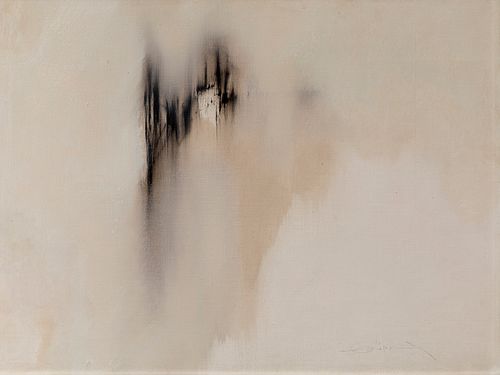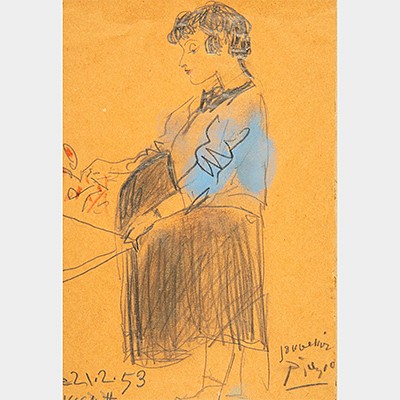FERNANDO ZÓBEL (Manila, Philippines, 1924 - Rome, Italy, 1984). "El rio XVII", 1978. Oil on canvas. Work referenced in the catalogue raisonné of the a
Lot 70
About Seller
Setdart Auction House
Carrer Aragó 346
Barcelona
Spain
Setdart Subastas was born in 2004 and is currently the first online art auction in Spain with solidity, prestige and reliability guaranteed by our more than 60,000 users. Setdart has a young, dynamic and enterprising team ready to successfully manage the purchase and sale of art works through custom...Read more
Estimate:
EUR€120,000 - EUR€130,000
$130,434.78 - $141,304.35
Absentee vs Live bid
Two ways to bid:
- Leave a max absentee bid and the platform will bid on your behalf up to your maximum bid during the live auction.
- Bid live during the auction and your bids will be submitted real-time to the auctioneer.
Bid Increments
| Price | Bid Increment |
|---|---|
| EUR€0 | EUR€10 |
| EUR€200 | EUR€25 |
| EUR€500 | EUR€50 |
| EUR€1,000 | EUR€100 |
| EUR€3,000 | EUR€200 |
| EUR€5,000 | EUR€500 |
| EUR€10,000 | EUR€1,000 |
| EUR€20,000 | EUR€2,000 |
| EUR€50,000 | EUR€5,000 |
About Auction
By Setdart Auction House
Sep 20, 2021
Set Reminder
2021-09-20 08:00:00
2021-09-20 08:00:00
America/New_York
Bidsquare
Bidsquare : CONTEMPORARY ART
https://www.bidsquare.com/auctions/setdart-auction-house/contemporary-art-7482
Setdart Auction House sofia@setdart.com
Setdart Auction House sofia@setdart.com
- Lot Description
FERNANDO ZÓBEL (Manila, Philippines, 1924 - Rome, Italy, 1984). "El rio XVII", 1978. Oil on canvas. Work referenced in the catalogue raisonné of the artist Fernando Zóbel (In preparation). It has barely perceptible flaws on the paint layer, a product of the technical evolution of this type of work. Signed in the right corner. Signed, dated and titled on the back. Measurements: 60.5 x 81 cm; 65 x 85 cm (frame). In 1971 Fernando Zóbel began a prolific path whose undisputed protagonist was the river Júcar. His research lasted for a whole decade, becoming a recurring theme in his painting until shortly before his death. The artist would view this natural landscape in all its contexts and during all seasons, capturing his contemplative impressions through the use of photographs, watercolours and sketches, on the basis of which he began larger works. In this work, in which Zóbel immortalised the river, he emphasised the use of reflections and the chromatic harmony based on a soft, vaporous range, complemented by linear elements that make up the dimensions and pictorial space. Starting from a material reality of the landscape towards an abstract conception of it, where disparate elements such as the fictitious and the real, or the pictorial and pictographic, come together to form a work of great lyrical content. Historian, patron of the arts, university professor and collector are some of the adjectives corresponding to the figure of Fernando Zóbel, one of the most outstanding painters of the 20th century in Spain. The training and cultivation of his personality never ceased to develop, with his love of books standing out. He studied Medicine in the Philippines and graduated in Philosophy and Arts at Harvard University in the United States, and it was at this time that he became interested and involved in the world of painting, influenced by the Boston School, whose palette showed almost pure colours framed by a very marked drawing. Thus, in 1951 he took up the chair of Fine Arts at the Ateneo de Manila. Zóbel's evolution and need to develop a personal artistic language led him to explore the world of abstraction influenced by Rothko, or the expressionism of Pollock or de Kooning, working on very valid non-figurative proposals. To this, it is necessary to add the great influence and interest he felt towards oriental cultures, and this desire was increased by his participation in a Chinese archaeological excavation discovered in the Philippine peninsula of Calatagan. As was said, Zóbel's work draws from the East, so much so that it is oriental calligraphy that gives rise to the presence of sinuous lines of great elegance, which can be seen in the work in question, in which the meticulous and thoughtful preliminary work can be appreciated. There is nothing left to chance in his apparently spontaneous paintings; they all contain a period of prior reflection and execution, because, as he said: "my process is the process of sketch, drawing, sketch and painting", a planning that gives rise to perfect scenographies formed by movement, lines, speed, space and light. His work is represented in important museums such as the Museo de Arte Contemporáneo Español in Valladolid, the Museum of Fine Arts in Boston, the Museo Nacional Centro de Arte Reina Sofía, the Museo de Bellas Artes in Bilbao, the Brooklyn Museum of Art in New York, the Joslyn Art Museum in Omaha (Nebraska), the Hispanic Society of America, as well as in collections such as Chase Manhattan Bank, the AENA Art Collection of Contemporary Art in Madrid, and the Banco Urquijo in Barcelona.
- Shipping Info
-
In-house shipping available. Please inquire at admin@setdart.com.
-
- Buyer's Premium



 EUR
EUR CAD
CAD AUD
AUD GBP
GBP MXN
MXN HKD
HKD CNY
CNY MYR
MYR SEK
SEK SGD
SGD CHF
CHF THB
THB


















